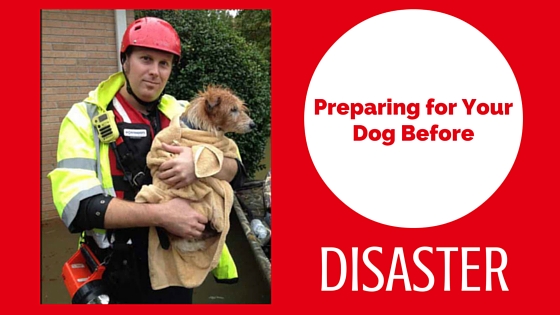Preparing for Your Dog before Disaster
June 1st, 2017 by Marlene Ring
We have all seen on the news, in times of disaster, many unfortunate pets are left behind.
 As responsible dog owners, we always think, “I’d never leave without my pets”. But if we haven’t planned ahead, the chances of a good outcome is less likely. Always hope for the best but prepare for the worst.
As responsible dog owners, we always think, “I’d never leave without my pets”. But if we haven’t planned ahead, the chances of a good outcome is less likely. Always hope for the best but prepare for the worst.
Planning ahead of time can make things go a lot smoother if disaster hits. Emergency often hits without warning and you might not have any time to prepare, later.
Let’s start with Proper Identification:
It’s a great idea to label collars with identifying information but it is absolutely essential to have your dogs microchipped.
The microchip is permanent whereas collars and tags can be misplaced. I remember volunteering at the Humane Society during the aftermath of Hurricane Katrina.
It was heartbreaking to wonder if these animals would ever be reunited with their grief-stricken families.
I microchip and, in addition, have identification and proof of rabies on their collars. Be sure to include a cell phone number in case your home phone is compromised during the disaster.
The veterinary number on the proof of rabies is exclusive to you and will also provide another contact. An address can be helpful especially if long distance rescue measures are necessary to reunite you with your dog.
Preparing a basic Disaster Kit for your pets:
If someone told you that you had fifteen minutes to get out of your house, what would you do?
Be sure to include your dogs in your plans.
Put a small box in a convenient place with some of the necessities for your dogs. Include a small bag of food, some water, medications with written instructions, leashes, a favorite toy, a blanket and a current picture of you with your dog.
Remember to grab their carriers.
Planning Where to Go:
In the event of a disaster, the first thought is TO GET OUT.
Listen to the radio or emergency personnel and drive away from the path of vulnerability. If you have time, researched locations in several directions. This will put you way ahead of the game.
You may have considered your friend in a certain town, but what if the roads are blocked to that location?
Of course the most important thing is to get out of immediate danger.
Work under the assumption that most emergency shelters don’t take dogs. Websites such as www.bringfido.com and www.dogfriendly.com are great places to find hotels and motels that are pet friendly.
They have listings nationwide which means that no matter where you plan on going, you’ll be able to find a spot to take you ALL in.
Plan for your pets in case you are not home:
I have a hard time even imagining not physically being there for my dogs!
A lot of us don’t think about this one. We just assume we’ll be there.
It’s a great asset if you have some neighbors or good friends that could step in if you couldn’t get home. Keep your pet sitter, dog walker or dog trainer informed and be sure that everyone knows where the disaster kit is kept.
Last minute Things to Know:
If it’s not safe for you then your pets are not safe either.
Always take your pets with you even if you think you’ll only be gone for a few hours. You never know if you’ll be able, or allowed, to get back home. If there are emergency warnings or the smell of fire, be prepared.
Don’t wait until you are forced to leave. Evacuate early!
If you have decided to stay home, choose a safe area and bring your disaster kit with you.
Block off any spots where your pet might hide making it hard for you to load them if you suddenly need to leave.
Think of it Like Insurance:
All this planning might sound like a lot to do ahead of time.
But if you think of it like car insurance, it makes more sense.
You hope that you will never have to use it but you wouldn’t think of risking going without it.
If every minute counts, you’ll be thankful you made a plan.


